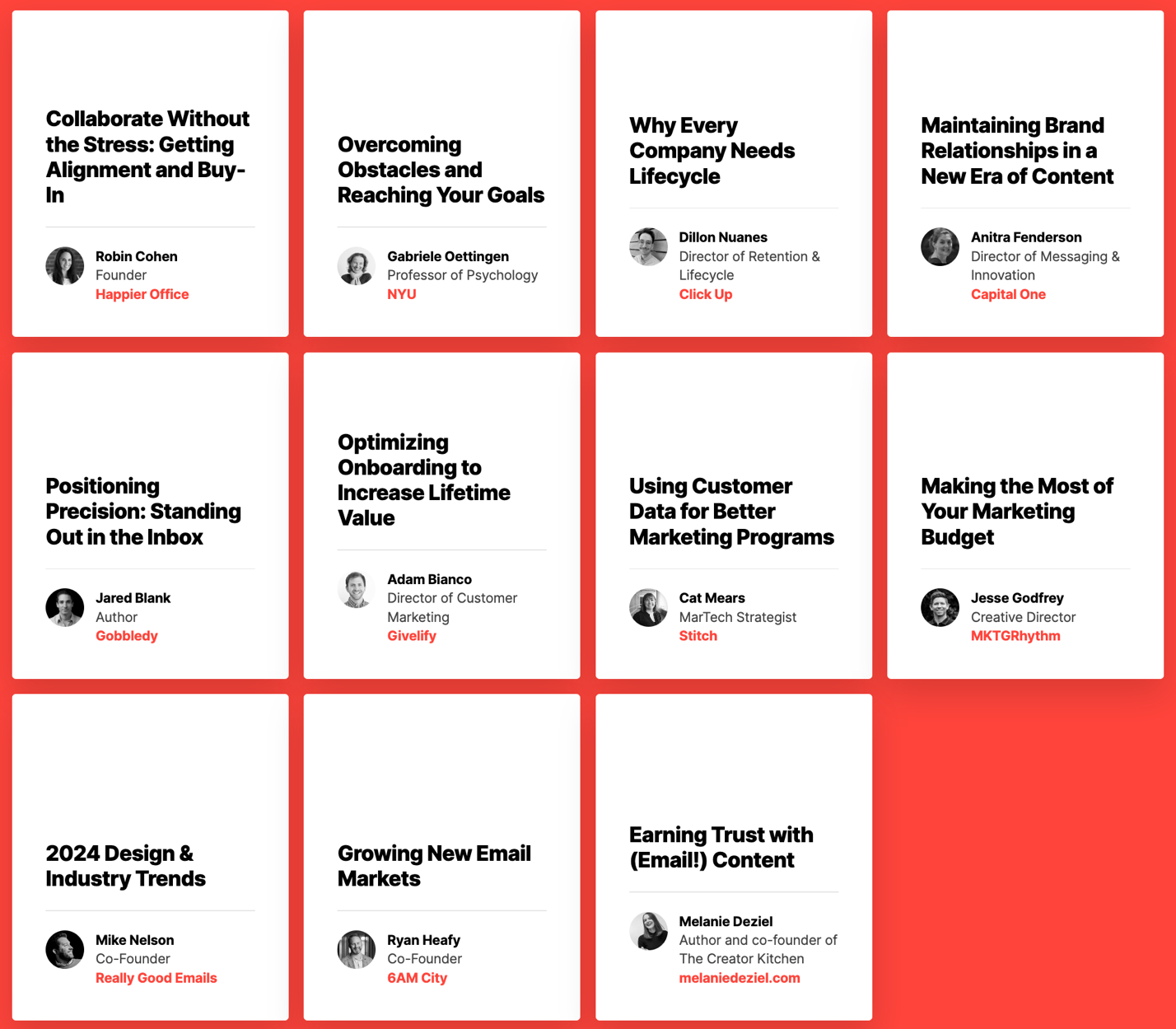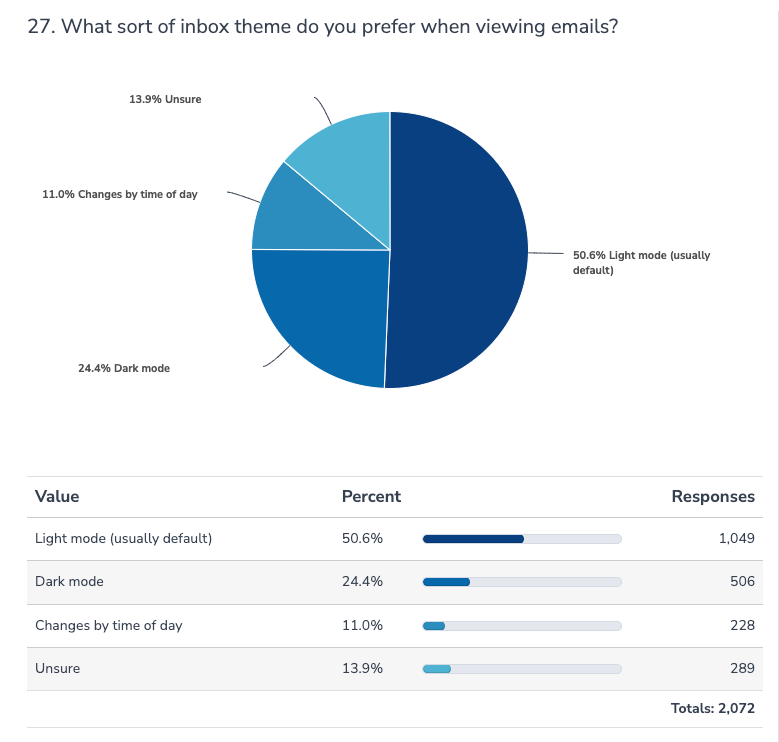We went to Unspam! Here’s what we learned
Unspam, the cult-favorite conference put on by Really Good Emails, just wrapped in Greenville SC. We went, we absorbed, and we bonded with the email community. Is email dead? What does the market look like? And what do you need to know about email? We’ve got some fresh takeaways in this post.
PUBLISHED ON
Here’s how Really Good Email’s describes Unspam, A rebel conference for email folks who hate boring conferences… unexpected, unconventional, and unforgettable. We know that email is never boring, and we bet you do too, but it can be challenging to convince email outsiders of the value of email, or the passion of the community.
While this conference is definitely a hub for the email-obsessed, the highlights and shared knowledge paint a pretty convincing picture as to why email is important and how it impacts companies and communication.
Table of contents
Color has gone to the dark side
Bolder is quicker
Building trust with authentication
Is email content important to deliverability?
Speakers and presenters
The Unspam 2024 speaker topics ranged from overcoming personal obstacles to growing new email markets. How to use customer data, design and industry trends, positioning, and how to stand out in the inbox were popular themes and the overall tone was about the future of email. Where is it going, how is it changing, and how can we improve along the way?

Speaker grid as seen on reallygoodemails.com
Emerging trends in email
We’re kicking off our takeaways by recapping Mike Nelson’s talk on design trends. We know, design isn’t a normal Mailgun topic but getting inside the consumer mindset is and design speaks to the very quick and visual ways that users interact with your messages from the inbox.
Here’s a couple key design trends taking center stage in 2024, and our two cents on what these trends mean in terms of customer behavior and experience.
Color has gone to the dark side
Gone are the pleasant pallets of pastels. Emails are trending dark for one simple reason. Dark mode is becoming more popular across devices.
Dark mode has some pretty practical advantages:
Less strain on your vision
Reduces blue light
Power saving (drains less battery resources)
More custom design options than light mode
If you look at the 2020 poll by Android Authority, over 80% of respondents said they enable dark mode whenever it’s available. In fact, Android recently announced that Android 15 will have a function allowing users to force apps to go dark – even if the apps don’t technically support dark mode or haven’t optimized for it.
Customers experience brand through emails, often more than any other medium.
Mike Nelson Co-Founder Really Good Emails
We recently polled on dark mode as well. Specifically to see what sort of themes email viewers prefer, and if that changes based on the time of day. What we found was that light mode was in the lead, but we suspect that has a lot to do with the fact that light mode is the default setting. 50.6% preferred light mode, and just under 25% opted for dark. Interestingly, there was an additional 11% that opted for a switch to dark mode depending on the time of day.
The undeniable trend is that the dark side is gaining more followers.

Bolder is quicker
It’s faster to convey simple messages like buy now, or we like to party when the text is bold and chunky. Big, beefy letters grab attention but there’s a caveat. While they’re great for design you want to be sure to leave the sentiment out of the subject line. Those bold phrases can make you look like a scammer if they’re in the wrong place.
Building trust with authentication
In our 2024 Email and the customer experience report we asked a lot of questions about why consumers choose to open emails and the most important thing for 65% of respondents was having familiarity with the brand sending the messages. Brand recognition ranked much higher in importance than having the promise of deal in the subject line.
If what Mike Nelson presented is true and Email is a primary way that customers experience your brand, then you have to ensure that your brand is viewed as a trusted sender. Part of that is building brand familiarity through things like content and design, but in email building trust is strongly tied to authentication.
Even Gmail and Yahoo are cracking down, and now requiring bulk senders to implement strong email authentications. Protocols like SPF, DKIM, and DMARC, help those mailbox providers verify your sender identity while keeping bad actors from imitating your brands.
Want to stand out in the inbox even more while also increasing trust and brand recognition? BIMI is an authentication that builds on DMARC, and shows off your brand logo right in the inbox. Learn more in our post on the BIMI email specification.
Standing out in the inbox
The inbox is a competition and sometimes messaging and positioning can go overboard. Jared Blank’s session was all about keeping language in check while Melanie Deziel’s talk was all about earning trust with email content. She noted that the best way forward is to follow the teachings of journalism, show don’t tell. Use your content to prove your claims.
Convenience claims: Things like speed and cost
Comparability claims: Statements that compare you to other similar products or services
Commitment claims: Showing value commitments as well as client commitments
Connection claims: Often catch-phrases that show intention like with State Farm Insurance, Like a good neighbor, State Farm is there.
Competence claims: Claims that speak to your follow through and core messaging
Going back to Jared Blanks session, just be sure your claims aren’t too Gobbledy, meaning keep the flowery software marketing jargon to a minimum and stick to your value propositions and the things that make you unique or reliable.
Is email content important to deliverability?
The short answer is yes. If you’re creating interesting content for your users, then they’re less likely to spam you. But content is more than just what you say, it’s who you say it to. Using tools like A/B testing for subject lines, personalization, and use of emojis. Is a good starting point.
A/B testing is a science, and it can help inform you on what strategies are working from your dynamic content to your designs. If you use it alongside tools like list segmentation you’ll wind up with a very targeted and optimized email program.
Your content and design won’t make an impact if your emails aren’t placed well in the inbox. Find out what it takes to get seen in our poston inbox placement and how it’s calculated.
Wrapping up
We’ll be exploring more of the topics from Unspam in the coming weeks. If you’re an email geek like us then subscribe to our newsletter so you don’t miss out on more industry news and email tips from our pros.





